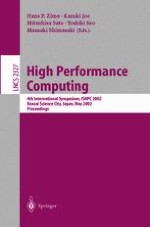2002 | OriginalPaper | Buchkapitel
An EPIC Processor with Pending Functional Units
verfasst von : Lori Carter, Weihaw Chuang, Brad Calder
Erschienen in: High Performance Computing
Verlag: Springer Berlin Heidelberg
Enthalten in: Professional Book Archive
Aktivieren Sie unsere intelligente Suche, um passende Fachinhalte oder Patente zu finden.
Wählen Sie Textabschnitte aus um mit Künstlicher Intelligenz passenden Patente zu finden. powered by
Markieren Sie Textabschnitte, um KI-gestützt weitere passende Inhalte zu finden. powered by
The Itanium processor, an implementation of an Explicitly Parallel Instruction Computing (EPIC) architecture, is an in-order processor that fetches, executes, and forwards results to functional units in-order. The architecture relies heavily on the compiler to expose Instruction Level Parallelism (ILP) to avoid stalls created by in-order processing.The goal of this paper is to examine, in small steps, changing the in-order Itanium processor model to allow execution to be performed out-of-order. The purpose is to overcome memory and functional unit latencies. To accomplish this, we consider an architecture with Pending Functional Units (PFU). The PFU architecture assigns/schedules instructions to functional units in-order. Instructions sit at the pending functional units until their operands become ready and then execute out-of-order. While an instruction is pending at a functional unit, no other instruction can be scheduled to that functional unit. We examine several PFU architecture designs. The minimal design does not perform renaming, and only supports bypassing of non-speculative result values. We then examine making PFU more aggressive by supporting speculative register state, and then finally by adding in register renaming. We show that the minimal PFU architecture provides on average an 18% speedup over an in-order EPIC processor and produces up to half of the speedup that would be gained using a full out-of-order architecture.
